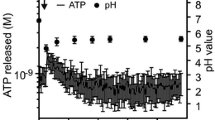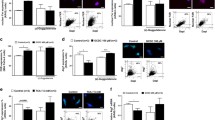Summary
The activation of 3H-labeled N-nitrosobis(2-oxopropyl)amine ([3H]BOP) by pancreas acinar and duct tissue from Syrian hamsters and MRC-Wistar rats in vitro was measured as DNA alkylation. Hamster tissue was incubated with [3H]BOP (0.1 mM; 20 μCi/ml) for 2 h. Initial levels of alkylation were similar, 41.7±3.7 (acinar) and 51.5±7.8 (duct) dpm/μg DNA. Alkylation persisted for longer in duct (t/2>46 h) than in acinar tissue (t/2=6 h). The faster repair of alkylation in acinar tissue was not due to acinar cell death. In rat duct tissue the level of alkylation 2 h after incubation (38.9±4.5 dpm/μg DNA) was similar to that in hamster ducts but declined more rapidly (t/2=27 h). Hamster and rat acinar and duct tissue was incubated with BOP followed by [3H]thymidine to measure DNA synthesis. BOP stimulated DNA synthesis in hamster but not in rat duct tissue or hamster acinar tissue. These data support the hypothesis that the duct tissue is the target tissue for BOP in Syrian hamsters.
Similar content being viewed by others
Abbreviations
- BOP:
-
N-nitrosobis(2-oxopropyl)amine (ACS registry no. 60599-38-4
- HBSS:
-
Hanks balanced salt solution
References
Bax J, Schippers-Gillissen C, Woutersen RA, Scherer E (1987) Immunocytochemical of O-6-methylguanine in nuclei of Syrian golden hamster pancreas after in vivo application of N-nitrosobis(2-oxopropyl)amine (BOP). Proc Am Assoc Cancer Res 28:126
Brannon PM, Orrison BM, Kretchmer N (1985) Primary cultures of rat pancreatic acinar cells in serum-free medium in vitro. Cell Dev Biol 21:6–14
Flaks B, Moore MA, Flaks A (1980) Ultrastructural analysis of pancreatic carcinogenesis: morphological characterisation of N-nitrosobis(2-hydroxopropyl)amine-induced neoplasms in the Syrian hamster. Carcinogenesis 1:423–438
Githens S, Holmquist DRG, Whelan JF, Ruby JR (1980) Ducts of the rat pancreas in agarose matrix culture. In vitro 16:797–808
Githens S, Finley JJ, Patke CL, Schexnayder JA, Fallon KB, Ruby JR (1987) Biochemical and histochemical characterisation of cultured rat and hamster pancreatic ducts. Pancreas 2:427–438
Helgeson AS, Pour P, Lawson TA, Grandjean CJ (1980) Exocrine pancreatic secretion in the Syrain golden hamster, Mesocricetus auratus. I. Basic values. J Comp Biochem Biuophys 66:473–477
Kissane JM, Robins E (1958) The fluorimetric measurement of deoxyribonucleic acid in animal tissues with special reference to the central nervous system. J Biol Chem 233:184–188
Lawson T, Nagel D (1988a) Activation of carcinogens by isolated pancreas cells. FASEB J 2:A386
Lawson T, Nagel D (1988b) The production and repair of DNA damage by N-nitrosobis(2-oxopropyl)amine and azaserine in hamster and rat acinar and duct cells. Carcinogenesis 9:1007–1010
Lawson TA, Gingell R, Nagel D, Hines LA, Ross AE (1981a) Methylation of hamster DNA by the carcinogen N-nitrosobis(2-oxopropyl)amine. Cancer Lett 11:251–255
Lawson TA, Helgeson AS, Grandjean CJ, Wallcave L, Nagel D (1981b) The formation of N-nitrosomethyl(2-oxopropyl)amine from N-nitrosobis(2-oxopropyl)amine in vivo. Carcinogenesis 2:845–849
Lawson T, Kolar C, Nagel D (1989) The mutagenicity of N-nitrosobis(2-oxopropyl)amine in V79 cells when activated by pancreas acinar and duct tissue from Syrian golden hamsters and MRC rats. Mutat Res (in press)
Lijinsky W, Ross AE (1969) Alkylation of nucleic acids not related to carcinogenesis by N-nitrosamines. J Natl Cancer Res 42:1095–1100
Lindamond C, Bedell MA, Billings KC, Swenberg JA (1982) Alkylation and de novo synthesis of liver cell DNA from C3H mice during continuous dimethylnitrosamine exposure. Cancer Res 42:4153–4157
Lowry OH, Roseborough NJ, Farr AL, Randall RJ (1951) Protein measurement with the Folin phenol reagent. J Biol Chem 193:265–275
Majmudar APN, Vesenka GD, Dubick MA, Geokas MC (1986) Evaluation of the role of calcium in cytotoxic injury in isolated rat pancreatic acini. Biochem Biophys Res Commun 139:530–537
Mangino MM, Hollenberg PF, Scarpelli DG (1988) The uptake of N-nitrosobis(2-oxopropyl)amine (BOP) by isolated rat and hamster hepatocytes: species differences and evidence for active transport. FASEB J 2:A386
Mitchell DB, Santone KS, Acosta D (1980) Evaluation of cytotoxicity in cultured cells by enzyme leakage. J Tissue Cult Methods 6:113–116
Nagel D, Kupper R (1981) Preparation of N-nitrosobis(2-oxopropyl)amine and the 1-14C analog. J Labelled Compd Radiopharm 16:1016–1019
Oliver C (1972) Isolation and maintenance of differentiated exocrine gland acinar cells in vitro. In vitro 16:297–305
Pour P, Althoff J, Kruger FW, Mohr U (1977) Improvement of the pancreatic cancer model by modified treatment with N-nitrosobis(2-oxopropyl)amine. Cancer Lett 2:233–238
Pour P, Salmasi S, Runge R (1978) Selective induction of pancreatic ductular tumors by single doses of N-nitrosobis(2-oxopropyl)amine in the Syrian golden hamster. Cancer Lett 4:317–323
Pour P, Salmasi S, Runge R, Gingell R, Wallcave L, Nagel D, Stepan K (1979) Carcinogenicity of N-nitrosobis(2-hydroxypropyl)amine and N-nitrosobis(2-oxopropyl)amine in MRC rats. J Natl Cancer Inst 63:181–190
Shortman KS (1968) The separation of different cell classes from lymphoid organs. II. The purification and analysis of lymphoid populations by equilibrium density gradient contrifugation. Aust J Biol Med Sci 46:375–396
Author information
Authors and Affiliations
Additional information
The work was supported by a grant from the National Institutes of Health (CA31016), a Laboratory Cancer Research Core Grant (CA 36727) from the National Cancer Institute, an Institutional Grant from thie American Cancer Society (ACS SIG 16) and an Eppley Institute Summer Internship to RG and EK
Rights and permissions
About this article
Cite this article
Lawson, T., Kolar, C., Garrels, R. et al. The activation of 3H-labeled N-nitrosobis(2-oxopropyl)amine by isolated hamster pancreas cells. J Cancer Res Clin Oncol 115, 47–52 (1989). https://doi.org/10.1007/BF00391599
Received:
Accepted:
Issue Date:
DOI: https://doi.org/10.1007/BF00391599




